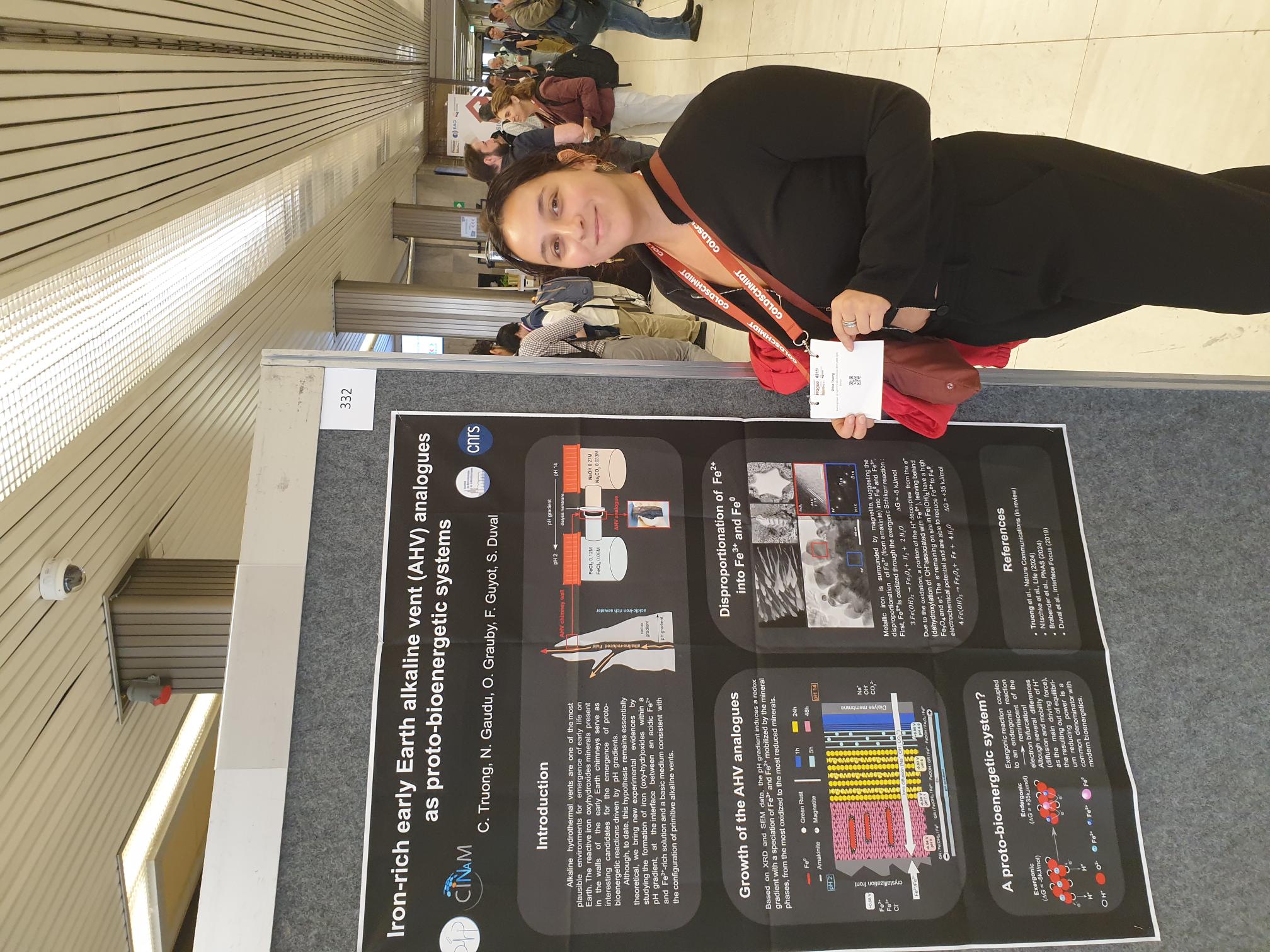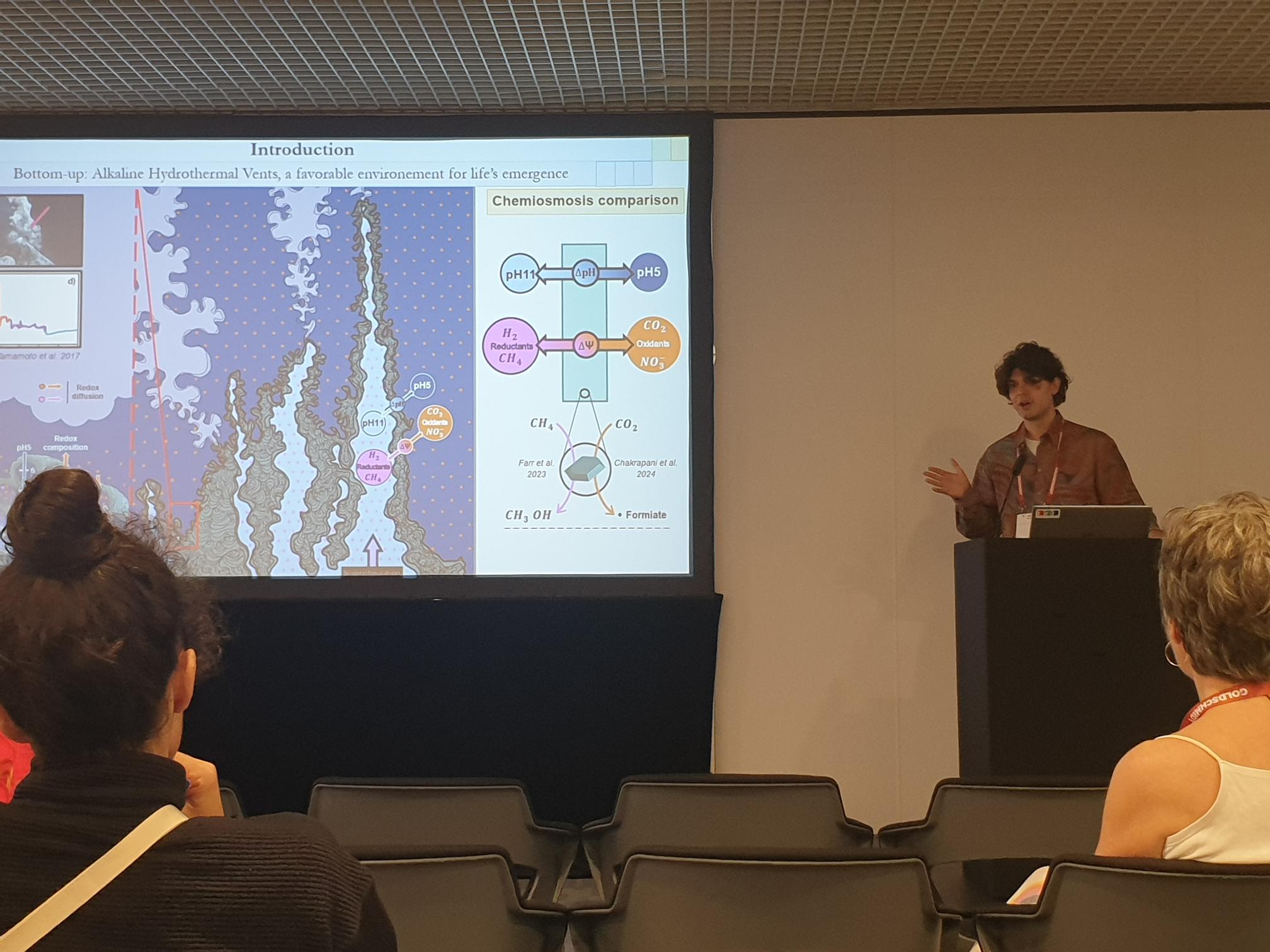Evolution de la bioénergétique
Evolution of bioenergeticsWelcome to BiP 09
BIP 09 works on the evolution of the bioenergetic system and the redox reactions that fuel all life on earth.
Starting from the very beginning we investigate transition metal-based energy conversion as a basis for the appearance of life on earth exploring the reactivity of fougerite and its derivatives.
Taking the story from the other end we reconstruct phylogenetic trees of extant enzymes to deduce the bioenergetic inventory of the Last Universal Common Ancestor of living beings. Our analysis revealed the structures of enzymes as an assembly of a limited set of building blocks that are arranged in many different ways to give rise to the wide variety of extant enzymes. This approach guides our research on individual enzymes: it influences the choice of our model organisms and informs the interpretation of results obtained on a specific enzyme by comparison to the other members of its enzyme family.
These bottom-up and top-down approaches join in our theoretical considerations of thermodynamics: the energy available in a couple of initial electron donor and terminal acceptor of a given chain, the resulting build-up of a transmembrane potential and more recently electron bifurcation as a disequilibrium generating device.
Molybdo-enzymes, Rieske/cytb complexes and Flavoenzymes are currently under study in our group. All three groups of enzymes have a wide distribution over the phylogenetic tree, potentially bifurcate electrons and adapt for Molybdo- and Flavoenzymes to a wide redox range and to different substrates.

Lab news

Subject: Utilization of Heterotrophic Substrates by Anammox Bacteria
Duration: 6 month – January 2026 to June 2026
Location: Platform Biomass, IMM-FR3479, CNRS-AMU, 31 chemin Joseph Aiguier, CS70071, 13009 Marseille
Supervisor : Marielle Bauzan, head of the platform BIOMASS-Fermentation
Website : https://www.imm.cnrs.fr/plateformes/biomasse-ingenierie-des-proteines/
Context :
Anammox bacteria were discovered in the 1990s and were soon recognized as major players in the global nitrogen cycle. They transform nitrite and ammonium into N₂ and fix CO₂ into their biomass under anaerobic conditions. These bacteria are found in marine and freshwater ecosystems and are used in wastewater treatment plants, where they allow for cost-efficient removal of fixed nitrogen (van der Star, 2007; Lackner et al., 2014). So far, no pure culture of anammox bacteria has been obtained.
The fermentation service at the Institute of Microbiology of the Mediterranean (IMM) in Marseille develops cultures of unconventional microorganisms such as extremophiles and strictly anaerobic bacteria. Since 2020 we operate an anmmox bioreactor as a chemostat with a 99% enriched culture of the freshwater species Candidatus Kuenenia stuttgartiensi. It produces biomass for fundamental research at the laboratory of Bioenergetics and protein engineering (BIP) laboratory of the IMM.
In addition to their autotrophic lifestyle, anammox bacteria can metabolize heterotrophic substrates (Kartal et al 2007a,b, 2008). Heterotrophic growth may play an important role in natural environments and in waste water treatment plants but it is barely studied. The presence of side populations of various Bacteria and Archaea in the enriched anammox cultures complicates investigations by conventional methods: Anammox bacteria double once a week under autotrophic conditions and side populations take over within a few weeks if heterotrophic substrates are present in the medium. Elucidating whether anammox bacteria incorporate heterotrophic substrates into their biomass or transform them into CO2 is important for the development of next generation waste water treatment plants. It is also important to understand whether the presence of organic molecules influences on their nitrogen metabolism.
Microcalorimetry was very recently applied to nitrogen metabolism of anammox bacteria at the M2P2 in the technical center at Arbois north of Mar
seille in collaboration with the fermentation service of the IMM and the BIP laboratory. This technic is well suited to investigate the heterotrophic metabolism of anammox bacteria, since the measurement can be completed within a few hours of culturing.
The implementation of anammox bacteria in the waste water treatment process is not yet well established in France, unlike in other countries like the Netherlands. The M2P2 is working on this subject and collaborating with companies such as ATHENA-Nantes. The fermentation service at the IMM is the only CNRS platform to obtain the label IBISBA (“infrastructure of synthetic biology”) for supporting research projects at the University, at the CNRS, and in industry, as well as for its commitment to train students from bachelor’s to PhD level at the University and in the European CIVIS program of Bioprocesses.
Objective and workflow :
Starting with biomass form the chemostat, the intern will develop small batch cultures of Candidatus Kueneia stuttgartiensis at the fermentation platform of the IMM under the supervision of Marielle Bauzan. She/he will trigger the metabolism by adding substrates, such as ammonium/nitrite, format/nitrate, acetate/nitrate or a mixture of these substrates. Substrate consumption will be monitored using using high-performance liquid chromatography (HPLC) for organic compounds and ion chromatography for nitrite and nitrate. These techniques as well as a glove box for experiments under strictly anaerobic conditions are accessible at the BIP laboratory in the same institute under the supervision of Frauke Baymann. The experiments will run for a few hours and no significant increase of side populations is expected. Regular optical microscopy controls will confirm this assumption. Once the kinetics of the format or acetate consumption characterized, the intern will perform the same experiment inside a microcalorimeter at the platform of the M2P2 laboratory at Arbois under the supervision of Jean-Henry Ferrasse. Heat released during anabolic metabolism (conversion of acetate or format into CO2 and ammonium and nitrite into N2) and heat taken up during catabolism (CO2 fixation and incorporation of acetate and format into biomass) will be measured with high precision (Tafoukt et al. 2017). Comparing the measured and calculated heat flow will allow to distinguish the incorporation of organic substrates into biomass from their transformation into CO2 (Wang et al. 2020). Experiments in the presence of nitrite and ammonium will reveal the influence of organic substrates on the anmmox reaction.
Profile of the candidate:
A background in microbiology and interest in thermodynamics are prerequisites for this internship. The intern will interact with different researchers on two platforms. The two places are connected by public transport. Please feel free to contact us if you would like more information.
To apply please send your CV, a motivation letter, a letter of recommendation and the report from your last year of Bachelor’s studies and your first year of Master’s studies (including grades and ranking, if available) by email to and .
Bibliography :
Kartal B, Rattray J, van Niftrik LA, van de Vossenberg J, Schmid MC, Webb RI, Schouten S, Fuerst JA, Damsté JS,Jetten MS, Strous M. (2007a) Syst. App. Microbiol., doi.org/10.1016/j.syapm.2006.03.004.
Kartal B, Kuypers MM, Lavik G, Schalk J, Op den Camp HJ, Jetten MS, Strous M (2007b) Environ. Microbiol.,doi.org/10.1111/j.1462-2920.2006.01183.x.
Kartal B, van Niftrik L, Rattray J, van de Vossenberg JL, Schmid MC, Sinninghe Damsté J, Jetten MS, Strous M (2008) FEMS Microbiology Ecology, doi.org/10.1111/j.1574-6941.2007.00408.x.
Lackner, S., Gilbert, E. M., Vlaeminck, S. E., Joss, A., Horn, H., van Loosdrecht, M. C. (2014 Water Res 55, 292-303
Tafoukt D, Soric A, Sigoillot JC, Ferrasse JH (2017) Bioproc and Biosys Eng, 40, 643-650
van der Star, W. R., Abma, W. R., Blommers, D., Mulder, J. W., Tokutomi, T., Strous, M. et al. (2007) Water Res 41, 4149-4163
Wang Y, Wang G. Moitessier N, Mittermaier AK (2020) Front. Mol. Biosci. , Sec. Biological Modeling and Simulation, Volume 7
Goldschmidt conference in Prague 2025. Nil and Simon presenting their work during an oral presentation and Chloé T with her poster. 
Goldschmidt conference in Prague 2025. Nil and Simon presenting their work during an oral presentation and Chloé T with her poster.

Simon Duval Obtained his « habilitation à diriger les recherche ». He can officially supervised phD student. 

Congrats to Nil Gaudu who obtained the Prize of the Best Poster at the GFB conference in Bedoin, France
Dr. Frauke Baymann released a pre print descirbing spectroscopic observations of anammox hydrazine synthase.
Check it out!
We have released a preprint of our findings on a novel green rust mediated methane oxidation reaction on ChemRxiv! 
We met with emergence of life researcher Dr. Michael J Russell and material scientists Drs. Daniel Ferry and Olivier Grauby to discuss future research directions and objectives on the interdisciplinary study of green rust.
">If you are interested in joining our GR-committee please contact us!

Dissolved metal ions and mineral-liposome hybrid systems: Underlying interactions, synthesis, and characterization
Lab photos



